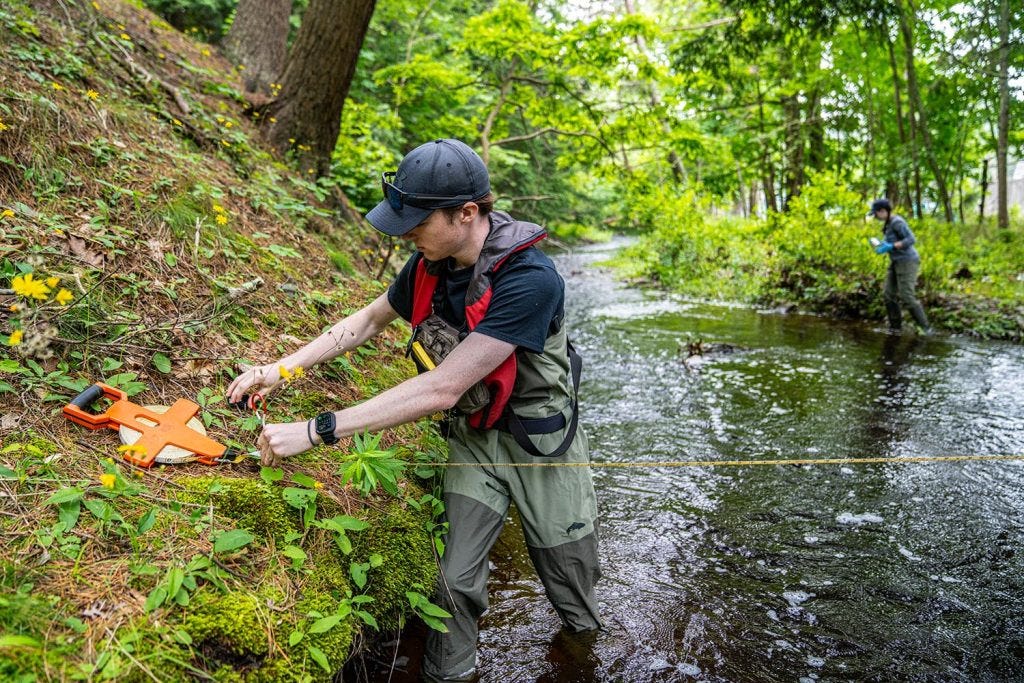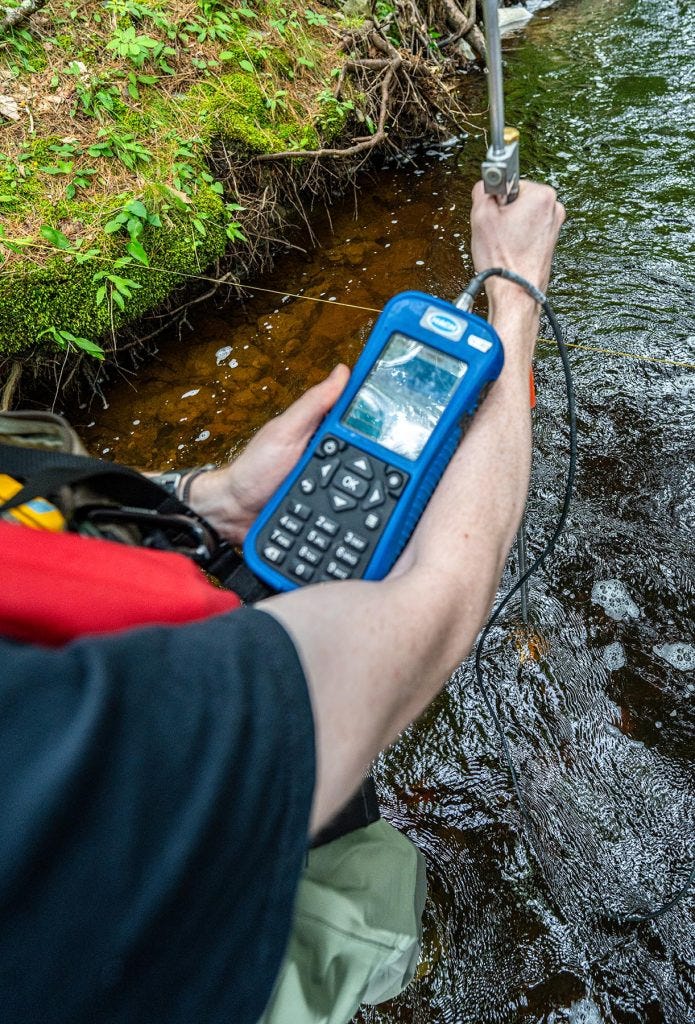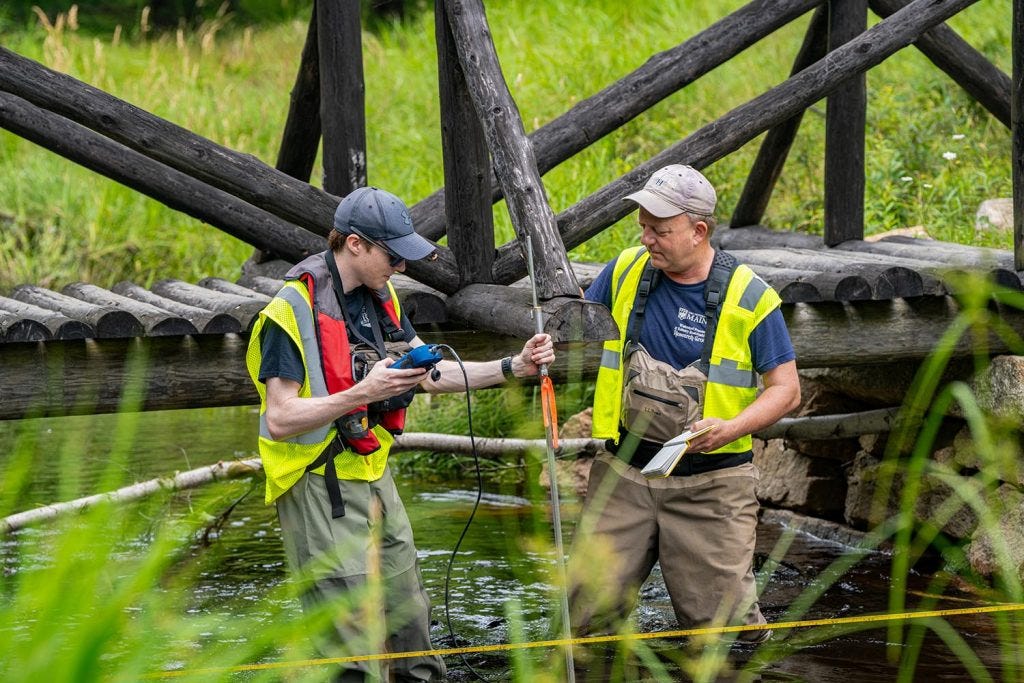Waters Along Bar Harbor, Acadia Home to Billions of Microplastics
Findings indicate that microplastics were transported from the land through the rivers and estuaries into Frenchman Bay
By University of Maine Orono/shared with permission
BAR HARBOR—Along the shores of Acadia National Park, Bar Harbor, and the Schoodic Peninsula are the vast, briny waters of Frenchman Bay. With 98 square miles of water and 39 islands, the bay is vital to shorebirds, fish, lobstermen, and outdoor recreationists. University of Maine researchers, however, have discovered that Frenchman Bay and its tributaries are also home to a significant amount of microplastic pollution.
In a new study published in Environmental Engineering Science, researchers reveal there are an estimated 400 billion microplastic fibers on the surface of Frenchman Bay and several connected rivers and estuaries where freshwater from rivers meet salty seawater. The watershed contains an average of 1.8 fibers per liter of water.
“Imagine the 32-ounce water bottle you use every day. If you were to fill your water bottle with water from Frenchman Bay, you would find about two microplastics. Now imagine how many water bottles would fit in the massive volume of Frenchman Bay; that is a lot of microplastics,” said Grace Johnson, lead author and master’s student in civil and environmental engineering.
Johnson collaborated with other UMaine students and faculty and researchers from the University of Notre Dame and Valparaiso University, both in Indiana.
Microplastics are smaller than five millimeters in length, tiny enough for humans and animals to ingest with ease, but trillions of them have been found in rivers, lakes and oceans worldwide. Examples include small pieces broken down from larger debris and minuscule beads manufactured for health and beauty products, according to the National Oceanic and Atmospheric Administration (NOAA).
Microplastics can impair digestion and reproduction in animals, and some of their additives are associated with endocrine disruption and cancer in humans, according to the U.S. Geological Survey. They can also absorb and transport other harmful toxicants that pollute waterways, including a group of chemicals known as PFAS.
Researchers conducted two water sampling campaigns for the study in 2022 and 2023. Using glass mason jars, they collected 129 samples in the bay, river and estuaries off the side of a boat in 17 weeks. Using microscopes, the fibers were pinpointed in the samples and their properties were analyzed by measuring their light signatures — the color and wavelengths of the light that cells reflect or absorb.
Concentrations of microplastics were, on average, highest in the bay itself, followed by the connected rivers and then the estuaries. Among the rivers, Egypt Stream in Franklin had the highest average concentration of microplastic fibers, followed by Kilkenny Stream in Hancock, then Union River, which passes through Ellsworth.
Among the estuaries, the one between Stave Island and Gouldsboro had the highest average concentration, followed by the Sullivan Estuary that leaves Egypt Bay, then Jordan River between Lamoine and Trenton.
“What is striking to me is that we collected water samples in the open ocean and we were still able to find one-to-two microplastic fibers in pretty much every liter we sampled,” said Onur Apul, study co-author, Johnson’s advisor and assistant professor of environmental engineering. “The quantities we are seeing in the natural environment are variable, but it is indicating that we created a new environmental domain — the ‘microplastisphere’ — during the extremely short timespan that we occupied the planet.”
The team also investigated how microplastics traveled throughout the watershed by sampling water from nine sites on Mount Desert Island, particularly within the town of Bar Harbor. In 2023, they collected water samples from the culvert at Grant Park, right across from Bubble Rock; a couple sites at Kebo Stream; and several sites at or near Cromwell Brook, including the wastewater treatment plant and a culvert for the transfer station. They sampled on clear days and during rain events, as culverts release stormwater.
The Grant Park culvert possessed the highest concentrations of microplastics by a wide margin at 15 fibers per liter, followed by the wastewater treatment plant, the transfer station and the other spots along Cromwell Brook and Kebo Stream. Average concentrations of microplastic fibers in all locations, however, were higher than those in the estuaries, rivers, and Frenchman Bay.
Study findings indicate that microplastics were transported from the land through the rivers and estuaries into Frenchman Bay. According to researchers, weaker currents allow fibers to remain in the bay for longer periods. The research team recommends additional studies into contamination in the bay and surrounding watershed to support possible techniques for mitigating the spread of microplastics.
“Once the microplastics are dispersed in Frenchman Bay there is no removing them, and they pose a threat to both marine life and humans. In the bay, fish and other marine species can ingest the microplastics, and when people eat the fish, they can also ingest microplastics. Therefore, it is important as a society that we create less plastic waste capable of ending up in the ocean,” Johnson said.
In addition to Johnson and Apul, other researchers involved in the project include UMaine graduate students Taylor Bailey, Dilara Hatinoglu and Bea Van Dam; UMaine faculty Lauren Ross and Sean Smith; Ph.D. student Ozioma Nwachukwu and associate professor Kyle Doudrick of Notre Dame; and professor Julie Peller from Valparaiso University.
“We find microplastics in fish tissue, in guano, in our beaches, in our drinking water, in the human brain and even in the human placenta,” Apul said. “Our recommendation is ‘mindful use,’ because plastics are very helpful in a lot of cases, such as medical use or food packaging, but some plastics are carelessly used and discarded. A plastic coffee stirrer, for example, has a use time of a few seconds. The second suggestion I have for people is preventing pollution by sustainability- and safety-focused policy making.”
If you’d like to donate to help support us, you can, but no pressure! Just click here.
If you’d like to sponsor the Bar Harbor Story, you can, too! That link is here.








Great article highlighting the ever increasing environmental impacts of irresponsible human behavior. Years ago when I took part in the Coastal Cleanup Program I would donate the use of my tour boat for transporting volunteers to islands in Frenchman Bay where they would collect and bag various items of trash along the shoreline. On one memorable 3 hour trip we filled the entire cockpit of a 40' lobster boat I borrowed for the day with contractor bags full of trash. Styrofoam cups, motor oil bottles, bleach bottles, running shoes, hundreds and hundreds of feet of polypropylene rope, rubber boots, one complete scuba divers wetsuit (with no one inside), styrofoam lobster buoys, items of clothing, styrofoam coolers, rubber gloves, beer cans and bottles, soda bottles, fish nets, and one large propane cylinder. When we ran out of room in the lobster boat we piled additional bags of trash into our 12' skiff. If memory serves it took 2 town dump trucks to transport the trash to the transfer station. Now comes the truly shocking part...using that 40' boat and 8 person crew it would probably take over a year of 8 hour days to make a meaningful dent in the trash piled up along the shores of Frenchman Bay!